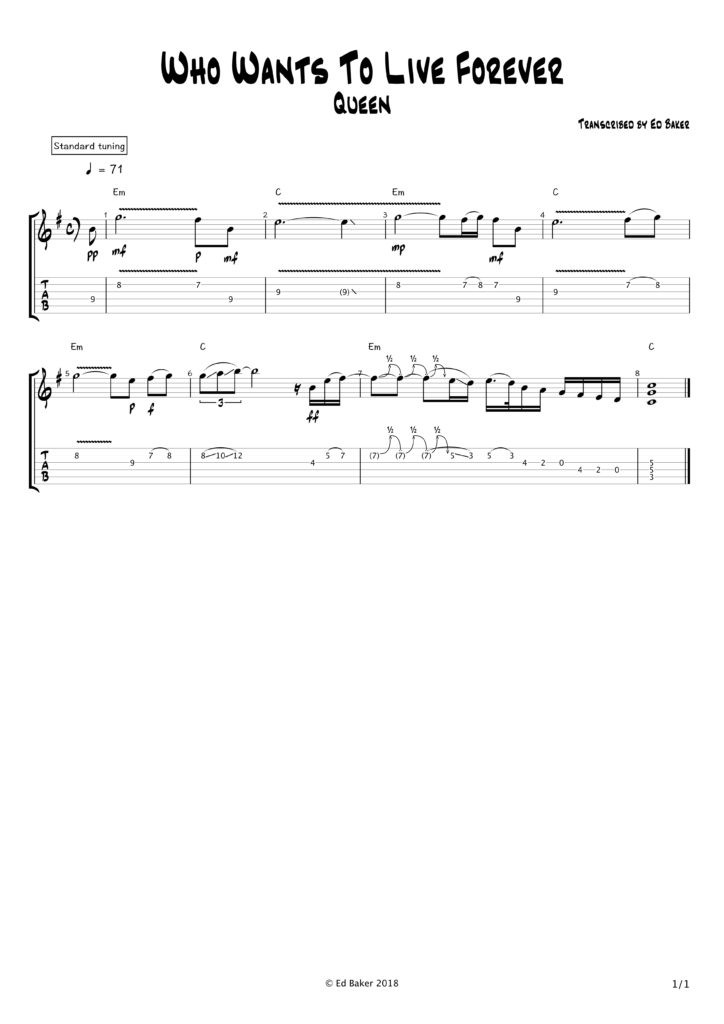For guitar players seeking inspiration from legendary musicians, Brian May of Queen stands as an icon. His distinctive guitar work is instantly recognizable, blending technical prowess with deep musicality. This week, we delve into a transcription of his guitar solo from the timeless ballad, “Who Wants To Live Forever”. This solo is a masterclass in crafting an impactful musical statement that’s both memorable and emotionally resonant, proving that complexity isn’t always the key to brilliance. It’s a fantastic study for understanding how to build a solo around the foundational Live Forever Guitar Chords.
Chord Tone Mastery in Soloing
Brian May’s genius often lies in his melodic phrasing and his innate ability to connect his solos to the underlying harmony. As you examine the transcription, you’ll notice his strategic use of chord tones. Above each bar, the chords are indicated, providing a roadmap to May’s note choices. This technique of targeting chord tones is fundamental in creating solos that feel both connected to the song and melodically strong. For instance, in the second bar, observe the sustained G note – it’s the 3rd of the Em chord, a prime example of how emphasizing chord tones creates melodic interest and harmonic coherence. Learning to identify and utilize chord tones like this is crucial for any guitarist aiming to improvise or compose expressive solos over chord progressions like those found in live forever guitar chords.
Building Solo Intensity and Dynamics
A hallmark of great solo construction is the ability to take the listener on a journey. Brian May excels at this by gradually increasing the intensity and note density throughout the solo. Notice how each phrase builds upon the previous one, accumulating in energy and drive. This solo is a perfect illustration of dynamic control in guitar playing. It begins with a more spacious and melodic approach and evolves into faster, more intricate lines, culminating in a powerful flurry of notes before resolving back to the underlying chord progression. This deliberate build-up is a technique every guitarist can learn to employ to captivate their audience and create solos that truly soar above the live forever guitar chords.
 Queen Guitarist Brian May Playing Live
Queen Guitarist Brian May Playing Live
Analyzing the “Live Forever Guitar Chords” Progression
The beauty of this solo is further enhanced when understood within the context of the song’s chord progression. “Who Wants To Live Forever” primarily revolves around a poignant and emotionally charged chord sequence, often simplified to Em – C – G – D in this section of the solo. These live forever guitar chords provide a rich harmonic foundation for May’s soloing. The Em (E minor) chord establishes a melancholic tone, moving to C major offers a lift, G major provides stability, and the D major chord creates a gentle resolution, before returning to Em or moving elsewhere in the song. May’s solo expertly navigates these changes, using the characteristics of each chord to inform his melodic choices and create a solo that is intrinsically linked to the song’s emotional core.
Time to Learn the Solo!
This transcription offers a fantastic opportunity to delve into the techniques of a guitar legend. By learning this solo, you’ll gain practical insights into chord tone soloing, dynamic phrasing, and how to construct a solo that complements the underlying harmony. Experiment with these concepts in your own playing over similar chord progressions, and you’ll be well on your way to crafting more expressive and engaging guitar solos.
If you’re looking for more solo transcriptions or want to deepen your understanding of guitar soloing techniques, explore our other lessons and resources. Do you have a favorite guitar solo you’d like to see transcribed? Or perhaps you’re interested in personalized guitar lessons to further develop your skills? Get in touch through our contact page, and let’s explore the world of guitar together!

